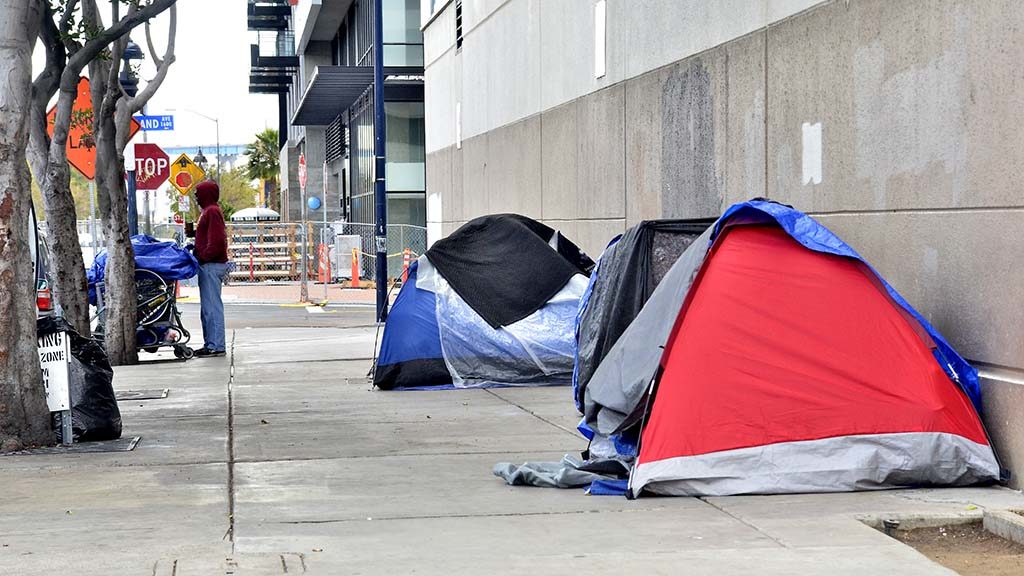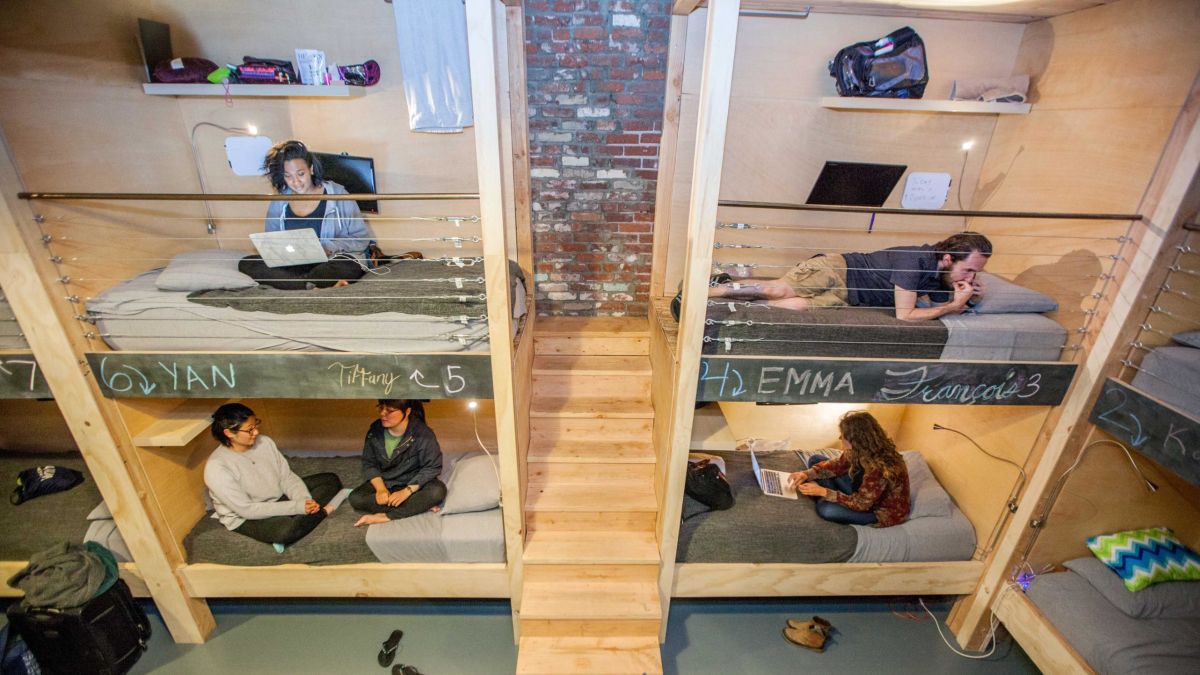
Moderators: Elvis, DrVolin, Jeff
Fine dining ‘with a view’ experience protested for being within view of homeless encampment
by John Gage
April 08, 2019
An anti-poverty group is staging protests against Toronto’s fine diners at the new pop-up restaurant experience Dinner With A View, which allows its guests to enjoy a luxury three-course meal while seated in a transparent dome with a 360-degree view.
The dining room is within sight of a homeless encampment.
“Toronto, like most cities, is in the midst of a housing crisis,” an organizer Yogi Acharya told the Washington Post. “There are people who are homeless who have nowhere else to go but under a highway. The brazenness of putting on meals like that not far from where people were hungry and cold all winter was jarring, and we believed it demanded a protest.”
The group, the Ontario Coalition Against Poverty has labeled the restaurant “Dinner With A View — of the Rich.”
“Homes Not Domes” and “Evict the Rich,” are just a few of the signs held by protesters angry that this fine dining experience would be placed under an overpass that the homeless, just a mile away, had been evicted from recently.
The luxury dome experience costs a minimum of $550, Canadian, for a group of four people to enjoy a menu of Italian, French, and Mexican-inspired food.
https://www.washingtonexaminer.com/news ... encampment

A completely luxurious dining experience in a highly unexpected setting. The adventure begins as guests are ushered into a unique outdoor space - a wondrous environment perfect for sharing via social.
Our domes are transformed into terrariums with distinct terrains. A terrarium is an elegant encapsulation of an ecosystem; a living biosphere captured in time. Here, we bring that notion to life inside our domes, each corresponding to a different region of the earth’s terroir: tundra, tropical, grasslands, arid and boreal forest. These extraordinary spaces are designed using resplendent materials such as live flora, luxurious textiles and elegant illumination.
The dining experience is anchored by the Chef’s savoir-faire, and the landscape from which our food is grown. For example, from award-winning René Rodriguez’ Mexican heritage to his exploration of French and Italian cuisine, the chef’s menu is truly embodiment of regional diversity.
The ingredients have been locally sourced by Chef Rodriguez, who designed and prepares a delicious 3-course blind menu, including meat, fish and vegan options.
Artistic spectaculars will frame the stage which will offer opportunities to capture that perfect photograph against an iconic urban background.”
https://www.dinnerwithaview.ca/en/about
/https://www.thestar.com/content/dam/thestar/opinion/star-columnists/2019/01/17/its-tough-to-be-homeless-in-toronto-and-its-getting-tougher/gardiner_tents_2.jpg)
/https://www.thestar.com/content/dam/thestar/opinion/star-columnists/2019/01/22/homelessness-is-an-emergency-but-we-have-to-do-more-than-just-treat-it-like-one/gardiner_tents.jpg)

Dinner With A View: Toronto's middle finger to the poor
Anger and contempt: protest of chi-chi dining pop-up under the Gardiner exposes the ever-widening fault line between haves and have-nots
by Peter Biesterfeld
April 10, 2019
Most of the 300 or so people who showed up to protest the swishy Dinner With A View dining pop-up under the Gardiner on April 5 are long gone. But the angry sound from the drums of Rhythms of Resistance, the samba-inspired collective that plays for social justice, continue to resound in the night, ricocheting off the concrete pillars soaring over the Bentway.
The popular event space that operates as an independent charity leased space to the Amex-sponsored dinner promoted as a “completely luxurious dining experience – in a unique outdoor space,” with locally sourced cuisine “designed” by Top Chef Canada winner Chef René Rodriguez.
But the “part pop-up restaurant, part outdoor oasis” offering up $100-a-plate dinners inside heated geodesic domes (reserved for an additional $149 and a short distance from where a tent city of homeless people was evicted last month) only serves to expose the widening fault line between haves and have-nots in the city.
The domes, each an illuminated “living biosphere,” sit like intergalactic pods waiting for lift-off behind a steel security fence lined with a black curtain for privacy. Swaths of the curtain come down when people gathering for the Ontario Coalition Against Poverty’s (OCAP) protest, called Dining With A View – Of The Rich, begin rocking the fence to reveal the diners in their bubbles.
The sarcastic outburst of applause from demonstrators that follows is met with equally contemptuous clinking of the wineglasses of a few of the diners who toast the protestors.
“I’m repulsed that somehow we are not all offended and enraged,” says Sarah Shartal, a lawyer who works with people who are marginally housed.
“It tells us something about the state of our city, who feels welcome, who feels safe, who has power and in this case, who profits,” says Ryan Hayes, a researcher with Workers United Canada and one of the featured speakers at the protest.
“Dining in a bubble for people who live in a bubble,” offers another demonstrator.
But in the battle of sound systems, dinner music for patrons in their domes is overpowered by OCAP’s speakers booming out Phil Ochs’s 1966 anthem, Ringing Of Revolution: “And the merchants of style, with their red velvet smiles….”
Meanwhile, at the busy Strachan Avenue entrance to the domes, police are escorting patrons past protestors who are banging pans and shouting “Shame on you!” Placards that read “Your privilege is showing” and “You’re being pretty shitty” are hoisted above the crowd. Safely inside, one of the patrons turns to face protestors and holds up both middle fingers.
OCAP organizer Gáetan Héroux says the decision to protest the event reflects a deep-seated anger over growing inequalities in our city. Says Héroux, “Like hell you’re going to flaunt your wealth in front of us while we suffer.”
On the grassy knoll overlooking the domed encampment, James Cushing, a retired union activist with the Ontario Public Service Employees Union joins the crowd in giving a collective middle finger to those in the domes below.
“It’s pretty disgusting that this takes priority for the city over homelessness,” he says. “That upsets the hell out of me.” On this side of the fence, volunteers are serving up their own dinner – samosas, roasted vegetables, cold-cut sandwiches and chocolate cake – to a long lineup of supporters.
Zoë Dodd, an organizer with the Toronto Overdose Prevention Society (TOPS), delivers the most poignant speech of the night.
TOPS, a collective of volunteers who opened the first overdose prevention site 18 months ago in response to the opioid crisis – saving hundreds of lives – now finds itself fighting the Ford government, which wants to shut them down.
“We cannot just be on our Facebook pages and on social media or be at rallies,” Dodd says. “We need to be seriously organizing because our earth is fucking dying, and people are living in arenas."
She nods in the direction of the Fort York Armoury nearby where the city temporarily warehouses homeless people during extreme cold weather alerts. “We can’t pay our rent and our province is being destroyed by cuts. And fuck the audacity of these motherfuckers eating here in their domes. I hope they’re uncomfortable.”
MORE: https://nowtoronto.com/news/dinner-with-a-view-protest/
 )
)The Basics of Pop-Up Restaurants
Originally started as supper clubs back in the 1960s, pop-up restaurants have seen a resurgence. Just as their name implies, pop-ups often occur in unexpected places, for a limited time.
Many chefs open a pop-up restaurant as a way to showcase their talents to a wider audience, perhaps drawing in investors for a restaurant in the future. Other pop-ups are a test run by would-be restaurateurs who are thinking of opening their own restaurant. Pop-ups are also used by community groups as fundraisers. Some pop-up proprietors seek to offer high-quality food at more affordable prices, allowing more people access to gourmet dining.
https://www.thebalancesmb.com/pop-up-re ... ts-2888299
Rather than adopt a more eco-friendly approach to life, most people have instead invested in a "claustrosphere", a dome-shaped habitat in which all water, food and air is endlessly recycled in a completely closed environment. A person can therefore survive indefinitely within a claustrosphere no matter what ecological horrors may happen outside.
The outrage expressed by Toronto's homeless advocates needs to spread far and wide.
Sounder » Fri Apr 12, 2019 10:57 am wrote:Cordelia wrote...The outrage expressed by Toronto's homeless advocates needs to spread far and wide.
Then perhaps more 'pop-ups' would be a good thing.

“CCNV, a controversial but innovative group that occasionally tangles with the law, has also made a cause celebre of salvaging edible food from supermarket dumpsters. It catered for a congressional committee a highly publicized lunch including crab quiche made from what they scavenged: food from a dumpster, discarded for being beyond the ''pull date'' and cosmetically imperfect produce. As a result of that demonstration and attendent publicity, both Giant and Safeway Supermarkets in Washington have agreed to allow authorized feeding groups to pick up daily loads of produce, dairy, and baked goods slated for the dumpster, screen them for edibility, then distribute them to soup kitchens and other programs.”
https://www.csmonitor.com/1982/1210/121044.html
At These Pop-Up Dinners, The Chefs (And The Guests) Are Homeless
Farming Hope teaches culinary skills to San Francisco’s homeless, and then serves meals where homeless diners eat side by side with people who pay full price for the meal.
By Adele Peters
On a recent night at a pop-up dinner in San Francisco’s Civic Center neighborhood–with a menu including seared mushroom red potato tostada and roasted broccoli with honey sriracha, some of the guests had paid $55 for a ticket for the multi-course meal. Other people, who are homeless, paid nothing. They sat together and talked, eating food prepared by people who are also homeless.
The startup nonprofit behind the dinner, Farming Hope, wants both to provide new job training for people who are trying to work their way out of homelessness–so they can later land jobs in the Bay Area food world–and to bring people together around food in a different way.
“We want an environment where it’s not just a restaurant where no one who’s very poor is coming to eat, and it’s not just a soup kitchen, where it’s only homeless people eating donated food as quickly as possible,” says Jamie Stark, one of the cofounders of Farming Hope. “It’s a nice environment where people want to be, where there’s a unique mix of people, and where some of that empathy and understanding and human-centered thinking can spread.”
Stark and cofounder Kevin Madrigal met as students at Stanford, where both had an interest in food as a tool for social empowerment and social change. They incubated the nonprofit in a summer business incubator at Stanford’s design school. In January 2017, they began working with their first cohort of employees in San Francisco–people who wanted to find jobs and begin to move out of homelessness.
As they initially began to design the nonprofit’s approach, they interviewed people experiencing homelessness and identified a key component–to feel needed. “Homelessness is not just a crisis of economic poverty, it’s also a crisis of social poverty,” Stark says. “So kind of rebuilding that sense of being needed in a community is incredibly important if you’re actually going to do transformational justice work, and get people into a different space and into the life they want to live.” Helping homeless people work with food and serve it to others, they realized, would be one way to address that need.
The program teaches participants to grow some of their ingredients, working in community gardens–including a rooftop garden on a local homeless shelter–and then offers training in cooking and serving restaurant guests. They quickly pared the training course down to three months to match the length of time that someone can have a bed at a homeless shelter.
“When we started last January, we were having guys doing really well with us–and then they would lose their beds and be off in the streets and they would drop off, because they didn’t have the stability,” says Stark. “So we really realized we had to work faster and better identify the folks who were very ready to get into employment, but they needed a job on their resume, they needed the confidence and the money, and somebody who could write them a letter of recommendation before they could get there. And we needed to push them to do this in a short enough timeline where they wouldn’t have everything upended when they had to move yet again.”
After the program, the nonprofit will help participants apply for a jobs. In the video below, one person who went through the program talks about the job he got with Whole Foods. Of eight participants in the startup program in 2017, four went on to get long-term, full-time employment.
MORE: https://www.fastcompany.com/40563529/at ... e-homeless
Everybody must get stoned: Clinton Park boulders are San Francisco’s clumsiest metaphor
By Joe Eskenazi | Sep 30, 2019
A sleeping man finds room between the anti-homeless stones placed on Clinton Park, purportedly by fed-up neighbors. Photo by Taylor Ahlgren
....
In San Francisco, perhaps the richest city in the history of cities or money, we’re fighting a proxy war over rocks. We’re doing this while the level of suffering on our streets resembles a scene out of a failed state. We’re doing this after the city’s neglect regarding unsafe and miserable conditions on this and so many blocks led residents to consider vigilantism as an attractive option (there was, apparently, no city permission sought nor granted prior to dumping tons of rocks on the sidewalk — this, in a city where installing a pink flamingo in the front yard likely requires several rounds of permitting).
https://missionlocal.org/2019/09/everyb ... t-metaphor
 ).
).
Four homeless men killed in Chinatown area of New York City
https://www.washingtonpost.com/nation/2 ... olice-say/

Tens of thousands of people experience homelessness there each year, and the problem has reached heights not seen since the Great Depression, according to the advocacy group Coalition for the Homeless. In August, over 61,000 people stayed in New York City homeless shelters each night, including over 21,000 children, according to the coalition’s data.
Grenfell Report Phase 1 Seeks to Blame the Firefighters
29 Oct, 2019 in Uncategorized by craig
One simple fact cannot be hidden. The firefighters did not cause the fire. Phase 1 of Judge Sir Martin Moore-Bick’s report of the public inquiry into the Grenfell disaster has been released to relatives prior to publication tomorrow. According to the Guardian, it concentrates blame on the firefighters in charge of tackling the blaze. This is an entirely predictable Establishment ploy; blame the little people.
I do not doubt mistakes were made by the firefighters; there will always be well-intentioned errors by those trying to cope with such a terrible crisis. Moore-Bick may be correct in his identification of them. Adherence to the established “stay in your flat” doctrine was disastrously wrong in these circumstances. But the firefighters were not the reason the fire started and spread so quickly. The primary reason was inadequate regulation of the burgeoning fashion for cladding old buildings, and inadequate enforcement of such regulation as was in place.
Moore-Bick may, a couple of years from now, ultimately produce a most damning report of government failings that caused the Grenfell Disaster. But these issues will only be dealt with as Phase 2 of the report, by which time public emotion and recollection will have faded further. I question the methodology of producing an initial report on the events of the night, and a second on the “historical background”, when the “historical background” actually contains the fundamental causes of the tragedy. The second report, when it eventually arrives, will have far less media coverage. The abiding message in the eyes of the duped public will be that the fault lay with the fire brigade.
So let us recall now what really happened.
Deregulation is fundamental to Tory ideology. Speaking specifically on multi-occupation buildings, Fire Minister Bob Neill stated on 16 June 2011:
Over the years, regulations – and the inspections and bureaucracy that go
with them – have piled up and up. This has hurt business, imposing real
burdens and doing real damage to our economy. Reducing the number
of rules and regulations is therefore absolutely central to the Coalition
Government’s vision for Britain, removing barriers to economic growth and
increasing individual freedoms. We have given a clear commitment that where
regulation cannot be justified, we will remove it.
That is one of many examples of vital context given in an excellent pamphlet by the Fire Brigades Union. It is the background to the government’s continued failure over years to address the need for new regulation of developments in cladding.
After six people died due to combustible cladding in the Lakamal House fire of 2009, Tory Minister Eric Pickles’ instinct was to use this disaster to reduce regulation; “My department is committed to a programme of simplification of building regulations”. In the seven years between that statement and the Grenfell fire, the coalition government had still done precisely nothing on cladding regulation.
Meantime, Boris Johnson as Mayor of London was taking an axe to the London Fire Service, closing twelve fire stations. Firemen involved in regulation and inspection were particularly cut. Johnson effectively reduced the number of firemen involved in operational regulation enforcement by half. Total fire brigade staff were reduced by a quarter.
..cont..
Craig Murray above wrote:
The Grenfell Tower fire: a crime caused by profit and deregulation
23 September 2019
Publication description
The FBU believes that the terrible loss of life at Grenfell Tower was ultimately caused by political decisions made at the highest level. For at least 40 years, policies relating to housing, local government, the fire and rescue service, research and other areas have been driven by the agenda of cuts, deregulation and privatisation.
In this pamphlet, the FBU shows how this political approach has weakened and undermined fire policy and the fire and rescue service. We believe a deep-seated culture of complacency has developed with regard to fire policy and fire safety. Ultimately, politicians at a ministerial level must bear responsibility for the creation of this complacency and its consequences.
Users browsing this forum: No registered users and 6 guests